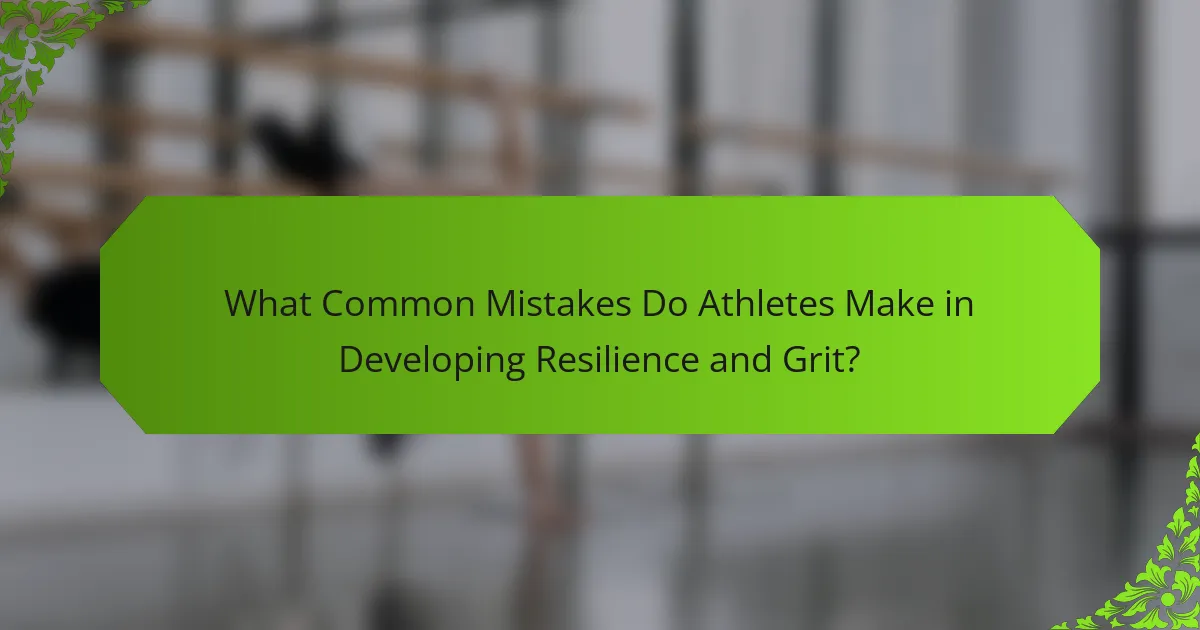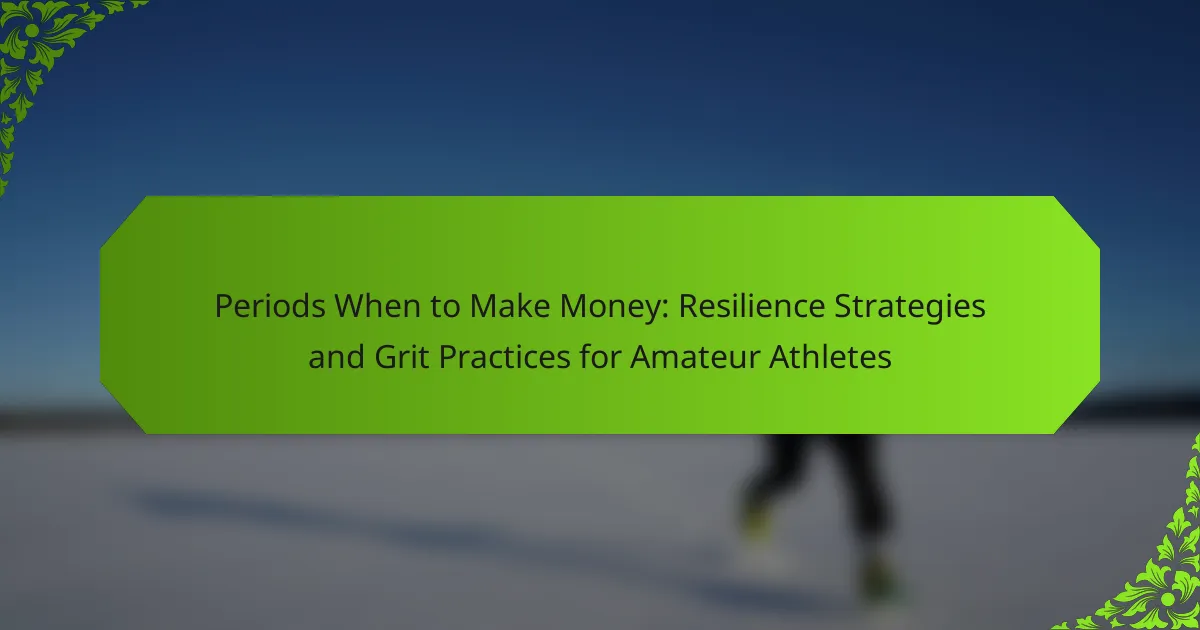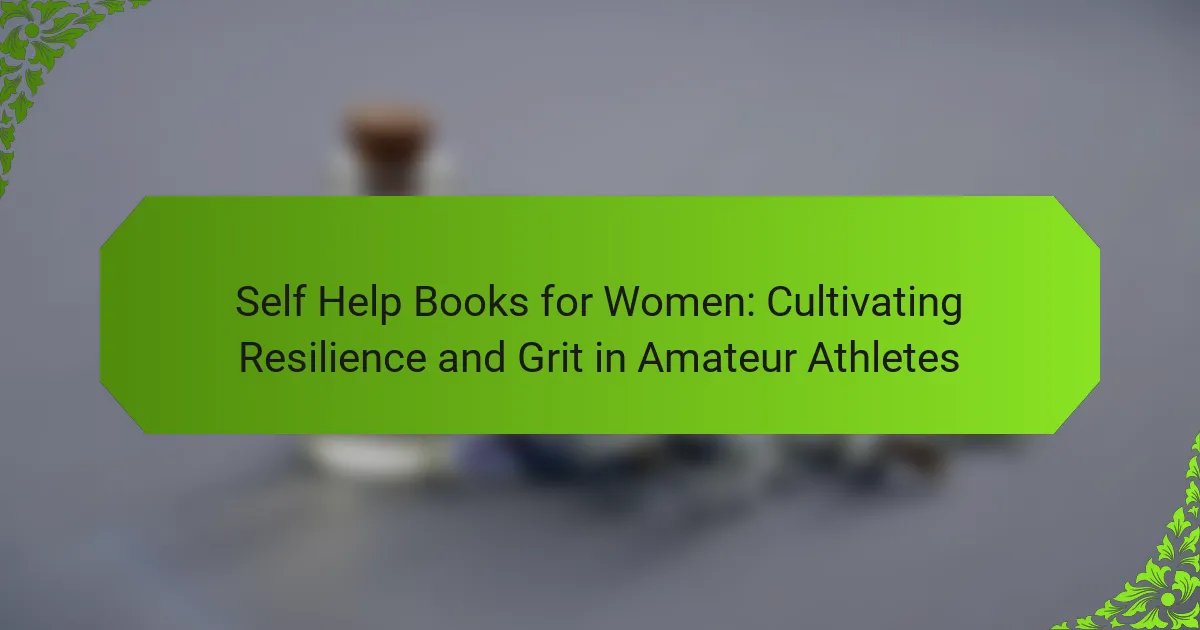Building resilience and grit is essential for amateur athletes facing competitive challenges. Intuition enhances quick decision-making and emotional regulation, while instinct provides immediate responses. Developing these attributes involves consistent practice, mental conditioning, and goal setting. Unique strategies like mindfulness and visualization further strengthen athletes’ performance under pressure.

How do Intuition and Instinct Contribute to Resilience in Amateur Athletes?
Intuition and instinct significantly enhance resilience in amateur athletes by fostering quick decision-making and emotional regulation. Intuition allows athletes to draw from past experiences, enabling them to adapt strategies under pressure. Instinct provides immediate responses to challenges, often without conscious thought, which can be crucial in competitive situations. Together, these elements cultivate grit, helping athletes overcome setbacks and maintain motivation. Studies show that athletes with strong intuitive and instinctive abilities often perform better in high-stress environments, reinforcing their resilience.
What is the difference between Intuition and Instinct?
Intuition involves a deep understanding or insight often developed through experience, while instinct is an innate response to stimuli. Intuition can guide amateur athletes in decision-making during competition, enhancing resilience and grit. Instinct, on the other hand, triggers immediate reactions, such as reflexes during gameplay. Both play crucial roles in athletic performance, but intuition allows for strategic thinking, while instinct drives quick, automatic actions. Understanding these differences helps athletes leverage their mental and physical strengths effectively.
Why is Resilience critical for Amateur Athletes?
Resilience is critical for amateur athletes as it enhances their ability to overcome challenges and setbacks. It fosters mental toughness, enabling athletes to maintain focus and motivation during difficult training and competition phases. Studies show that resilient athletes are more likely to persist in the face of adversity, improving their performance over time. This unique attribute of resilience not only contributes to athletic success but also supports overall well-being, making it essential for long-term development in sports.
What are the key components of Resilience?
Resilience in amateur athletes encompasses mental toughness, adaptability, and emotional regulation. These components enable athletes to overcome challenges, maintain focus, and persist through setbacks. Mental toughness allows athletes to push through adversity, while adaptability helps them adjust strategies in response to changing circumstances. Emotional regulation aids in managing stress and maintaining motivation. Together, these elements foster grit, essential for long-term success in sports.

What Universal Practices Enhance Grit in Amateur Athletes?
Developing grit in amateur athletes can be enhanced through consistent practice, mental conditioning, and goal setting. These universal practices cultivate resilience and determination.
1. **Consistent Practice**: Regular training builds muscle memory and confidence, fostering a strong work ethic.
2. **Mental Conditioning**: Techniques such as visualization and mindfulness prepare athletes for challenges, enhancing focus and perseverance.
3. **Goal Setting**: Establishing clear, achievable goals motivates athletes to push through obstacles, reinforcing their grit.
4. **Positive Reinforcement**: Encouragement from coaches and peers boosts morale, promoting a growth mindset.
5. **Adaptability**: Learning to adjust strategies in response to setbacks develops resilience, a key component of grit.
How does goal-setting impact Grit?
Goal-setting significantly enhances grit by providing clear objectives and motivation for amateur athletes. When athletes set specific, measurable goals, they cultivate perseverance and resilience in the face of challenges. Research indicates that goal-oriented individuals are more likely to maintain focus and commitment, leading to improved performance and greater grit over time. This connection emphasizes the importance of structured goal-setting in developing mental toughness and sustained effort in sports.
What role does consistent training play in developing Grit?
Consistent training is essential for developing grit in amateur athletes. It fosters resilience through repeated exposure to challenges, enhancing mental toughness. Regular practice builds a habit of perseverance, allowing athletes to overcome obstacles and setbacks. Research shows that athletes who engage in structured training programs demonstrate higher levels of grit, as they learn to push through discomfort and stay committed to their goals. This process not only strengthens their physical abilities but also cultivates a mindset geared towards long-term success.
What are effective training techniques for building Grit?
To build grit in amateur athletes, effective training techniques include setting challenging goals, fostering a growth mindset, and encouraging perseverance through failure. These approaches enhance resilience and promote long-term commitment to athletic development.
One technique is to implement progressive challenges that gradually increase in difficulty. This method helps athletes develop coping strategies and strengthens their resolve. Another technique is to cultivate a supportive environment that emphasizes effort over outcome, reinforcing the idea that persistence leads to improvement.
Additionally, incorporating reflective practices, such as journaling or group discussions, allows athletes to process experiences and learn from setbacks. These methods collectively build a foundation of grit, essential for both athletic success and personal growth.

What Unique Strategies Foster Intuition in Athletic Performance?
Unique strategies that foster intuition in athletic performance include mindfulness training, visualization techniques, and situational awareness exercises. Mindfulness enhances focus and present-moment awareness, allowing athletes to make quicker decisions. Visualization improves mental rehearsal, enabling athletes to anticipate scenarios and react instinctively. Situational awareness exercises cultivate an understanding of environmental cues, enhancing responsiveness during competition. These methods build resilience and grit, essential attributes for amateur athletes striving to improve their performance.
How can visualization techniques enhance Intuition?
Visualization techniques can significantly enhance intuition by fostering mental clarity and focus. These techniques help amateur athletes create mental images of their performance, improving decision-making and reaction times. For example, visualizing successful execution of skills reinforces neural pathways, making responses more instinctive during competition. This practice builds resilience by allowing athletes to mentally rehearse challenges, thereby increasing grit and perseverance. Engaging in regular visualization can lead to a unique attribute: heightened situational awareness, which is essential for athletic success.
What is the impact of self-reflection on Intuition?
Self-reflection enhances intuition by allowing amateur athletes to analyze their experiences and emotions. This process fosters resilience and grit, essential traits for overcoming challenges. Studies show that athletes who engage in self-reflection demonstrate improved decision-making and heightened awareness of their instincts. As a result, they can better trust their intuitive responses during competition, leading to enhanced performance.

What Rare Attributes Influence Instinctual Decision-Making?
Rare attributes influencing instinctual decision-making include emotional resilience, cognitive flexibility, and situational awareness. Emotional resilience allows athletes to recover quickly from setbacks, enhancing decision-making under pressure. Cognitive flexibility fosters adaptability, enabling quick adjustments in strategy. Situational awareness helps athletes read their environment, making informed choices. These attributes collectively enhance performance and grit in amateur athletes.
How do environmental factors shape Instinct in athletes?
Environmental factors significantly influence instinct in athletes by shaping their responses to challenges. Factors such as climate, terrain, and social dynamics affect decision-making and adaptability. For example, athletes training in high-altitude areas develop enhanced endurance and resilience. These adaptations foster instinctual reactions, enabling quicker responses during competition. The unique attribute of an athlete’s environment can cultivate grit, helping them overcome adversity. As a result, the interplay between surroundings and instinct is crucial for building mental toughness in amateur athletes.
What role does emotional intelligence play in instinctual responses?
Emotional intelligence significantly enhances instinctual responses by enabling athletes to manage emotions effectively. This skill fosters resilience and grit, allowing amateur athletes to navigate challenges and stressors. High emotional intelligence leads to better decision-making under pressure, enhancing performance and adaptability. It also promotes self-awareness, helping athletes recognize their emotional triggers and instinctual reactions, ultimately improving their instinctual responses in competitive situations.

How can Amateur Athletes Balance Intuition and Instinct for Optimal Performance?
Amateur athletes can balance intuition and instinct by practicing mindfulness and self-reflection. This approach enhances decision-making and performance under pressure. Intuition guides athletes based on past experiences, while instinct responds to immediate situations. Developing both fosters resilience and grit, crucial for overcoming challenges. Regular training that emphasizes situational awareness strengthens these attributes, leading to improved outcomes in competitive environments.
What are the best practices for integrating Intuition and Instinct?
To integrate intuition and instinct effectively, amateur athletes should focus on consistent practice and self-reflection. Building resilience involves training the mind to trust gut feelings while analyzing past experiences. Regularly engaging in mindfulness exercises can enhance awareness of instinctual responses. Setting specific goals helps athletes differentiate between instinctual reactions and intuitive insights, fostering better decision-making. Additionally, seeking feedback from coaches can refine these skills, promoting growth in performance.

What Common Mistakes Do Athletes Make in Developing Resilience and Grit?
Athletes often overlook mental strategies, leading to poor resilience and grit development. Common mistakes include neglecting emotional regulation, failing to set realistic goals, and underestimating the importance of recovery. Additionally, many athletes rely solely on instinct rather than intuitive decision-making, which can hinder their long-term performance. Emphasizing a balanced approach that integrates both mental and physical training can enhance resilience and grit effectively.
How can athletes avoid over-reliance on Intuition?
Athletes can avoid over-reliance on intuition by developing structured decision-making processes. Implementing strategies such as setting clear goals, practicing critical thinking, and seeking feedback enhances resilience. Engaging in deliberate practice fosters grit, allowing athletes to balance instinct with informed choices.
What are the pitfalls of neglecting Instinctual training?
Neglecting instinctual training can hinder an athlete’s ability to respond effectively under pressure. This oversight may lead to reduced performance, as instinctual responses are crucial for quick decision-making in high-stakes situations. Without this training, athletes may struggle to adapt to unexpected challenges, undermining their resilience and grit. Additionally, the lack of instinctual development can result in increased anxiety and hesitation during competitions, ultimately impacting overall athletic success.

What Expert Insights Can Help Build Resilience and Grit?
Expert insights emphasize the importance of understanding intuition and instinct in building resilience and grit in amateur athletes. Intuition often guides quick decision-making based on experience, while instinct involves automatic responses to situations. Developing resilience requires athletes to trust their intuition during high-pressure moments, enhancing performance. Grit, characterized by perseverance and passion, can be cultivated through consistent practice and mental conditioning. Research shows that athletes who embrace both intuition and instinct exhibit greater adaptability and success in competitive environments.
What actionable tips can improve Resilience in training?
To improve resilience in training, athletes should focus on mental strategies, physical conditioning, and supportive environments.
1. Set specific, achievable goals to foster a sense of purpose and direction.
2. Incorporate varied training routines to build adaptability and prevent burnout.
3. Practice mindfulness techniques to enhance focus and emotional regulation.
4. Engage in positive self-talk to reinforce confidence and perseverance.
5. Establish a supportive network of coaches and peers to encourage accountability and motivation.
How can athletes cultivate a growth mindset for Grit development?
Athletes can cultivate a growth mindset for grit development by embracing challenges and learning from failures. This mindset fosters resilience, allowing athletes to persist in the face of adversity. Incorporating reflective practices, such as journaling or seeking feedback, enhances self-awareness and promotes continuous improvement. Additionally, surrounding oneself with supportive peers and mentors can reinforce positive attitudes towards learning and growth. Adopting these strategies leads to a stronger mental framework essential for long-term athletic success.


